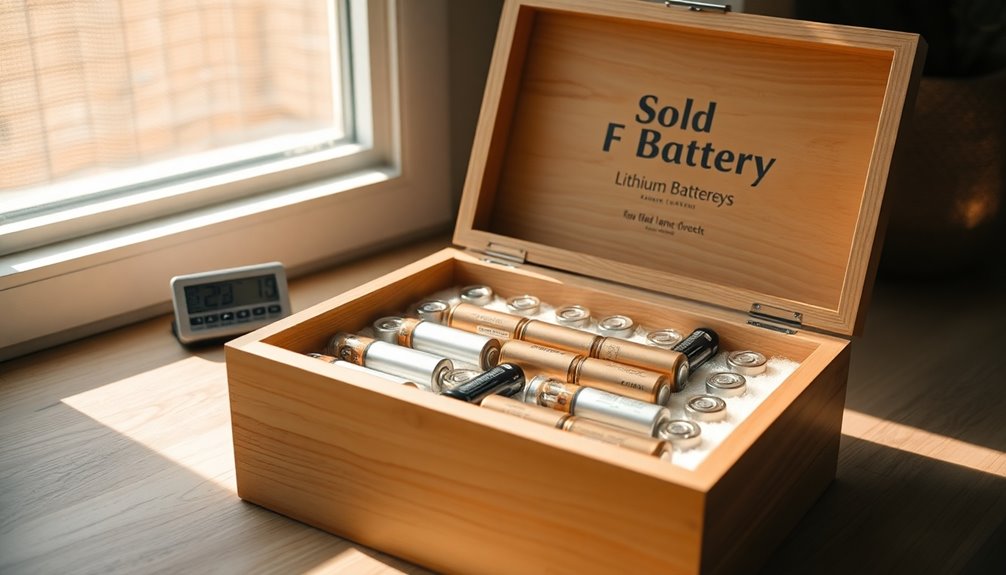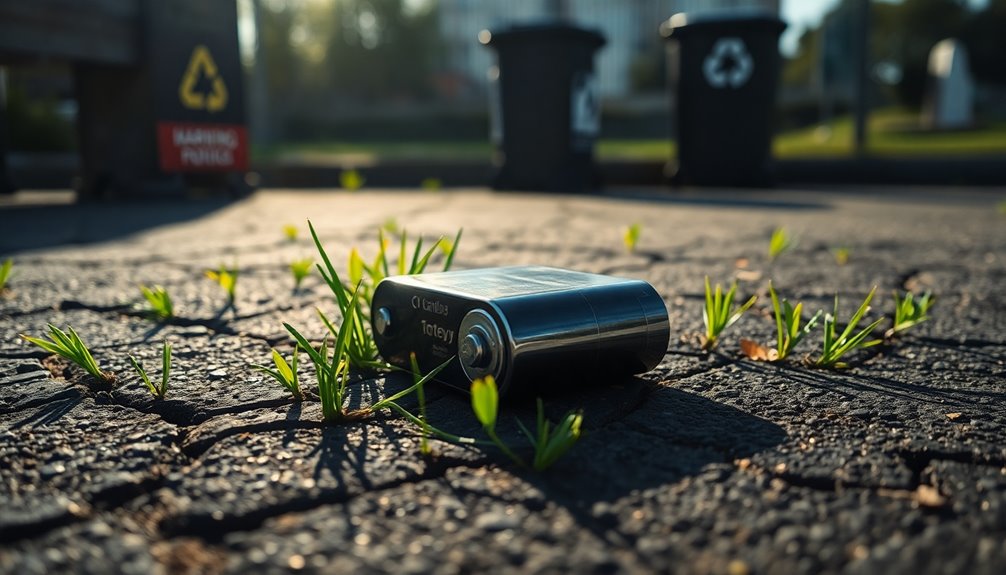To store lithium batteries safely and prolong their life, keep them in a cool, dry environment with temperatures between 20°C to 25°C (68°F to 77°F). Maintain humidity levels below 60% and use dehumidifiers if necessary. Store batteries at a charge level of 40-60% to minimize stress, and avoid letting them drop below 20%. Organize them by type and check their condition every few months. Use non-conductive storage containers for added safety, and always handle them with care. Stick around, and you'll discover even more essential tips to enhance battery longevity!
Key Takeaways
- Store lithium batteries at a temperature between 20°C and 25°C to prevent damage and capacity loss.
- Maintain charge levels between 40-60% for optimal battery health and longevity.
- Keep humidity levels below 60% to avoid moisture-related damage; use dehumidifiers if necessary.
- Organize batteries by type and age, and maintain records of charging dates and health assessments.
- Regularly inspect batteries for signs of damage, swelling, or leakage, and handle them according to safety guidelines.
Importance of Safe Storage
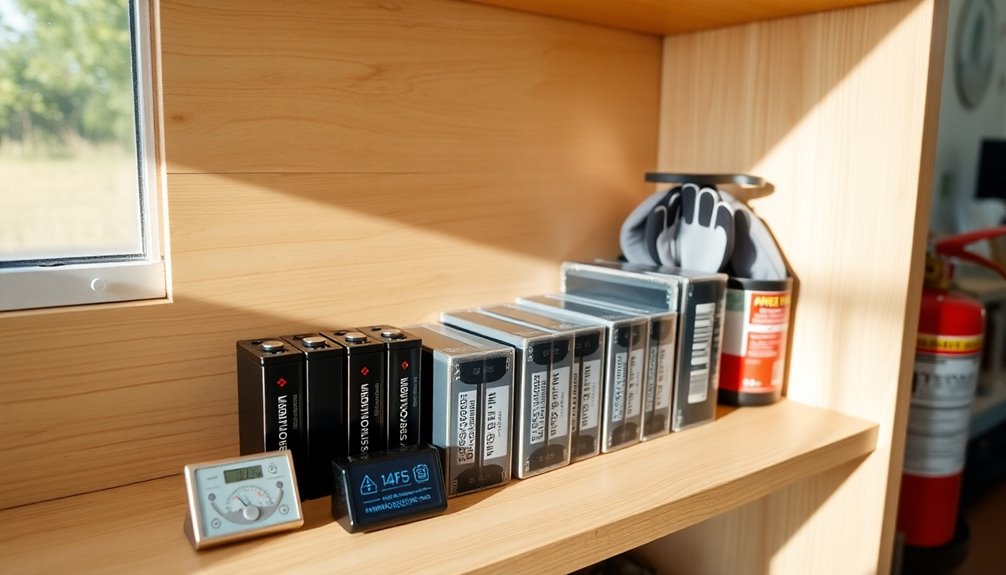
When it comes to storing lithium batteries, understanding the importance of safe storage can't be overstated. By maintaining the ideal temperature and charge level, you can greatly extend battery life and minimize capacity loss.
Aim to store your batteries at a charge level between 40-60%, as this balance helps prevent degradation over time. Regularly monitoring storage conditions, like temperature and humidity, is essential; high humidity can lead to corrosion, impacting performance.
Organizing batteries by type and age, along with keeping records of their charging history, guarantees safe storage and reduces the risk of chemical interactions.
Finally, using non-conductive dividers can protect against physical damage, making certain your batteries remain in prime condition for future use.
Ideal Temperature Ranges
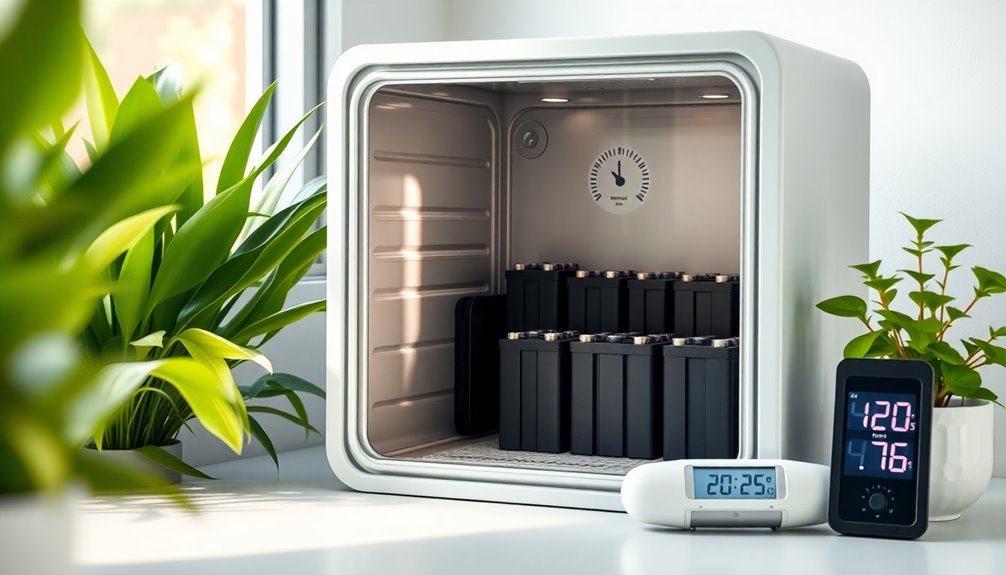
To keep your lithium batteries in top shape, aim for a storage temperature between 20°C and 25°C (68°F to 77°F).
Extreme temperatures can cause serious damage, so it's essential to avoid both the cold and heat.
Regularly check your storage conditions to guarantee your batteries maintain their performance and longevity.
Optimal Storage Temperatures
Storing lithium batteries at the right temperatures is crucial for maintaining their performance and longevity. The ideal temperature range for lithium batteries is between 20°C to 25°C (68°F to 77°F).
When you store batteries within this favorable range, you minimize battery degradation and keep self-discharge rates low. High temperatures can greatly impact battery health, leading to irreversible damage if batteries are exposed to extremes, such as above 100°F or below 20°F.
To guarantee long-term storage success, avoid direct sunlight and heat sources, and monitor your ambient temperature regularly.
Effects of Temperature Extremes
Extreme temperatures can have serious consequences for lithium batteries, affecting their performance and safety considerably.
- High temperatures can lead to capacity loss and hazardous situations.
- Low temperatures can reduce functionality and overall battery health.
- Fluctuating temperatures exacerbate self-discharge rates.
The ideal storage temperature range for lithium batteries is between 20°C to 25°C (68°F to 77°F) to guarantee peak performance.
When exposed to temperature extremes—below 20°F or above 100°F—you risk irreversible damage that can accelerate battery degradation.
High temperatures, particularly above 30°C (86°F), increase the likelihood of safety hazards like fires or explosions.
Conversely, freezing conditions can severely impact capacity and functionality.
As a result, maintaining consistent temperature control is vital for prolonging battery life and guaranteeing safe usage.
Monitoring Temperature Conditions
While maintaining the ideal storage temperature range for lithium batteries is essential, regularly monitoring these conditions guarantees their longevity and performance. The recommended temperature is between 20°C to 25°C (68°F to 77°F). Exceeding this range can lead to capacity loss and decreased efficiency.
| Temperature Range | Effect on Lithium Batteries | Monitoring Tips |
|---|---|---|
| 20°C – 25°C | Ideal for storage | Use a thermometer |
| 30°C and above | Increased capacity loss | Check regularly |
| Below 0°C | Structural damage | Avoid freezing storage |
Managing Humidity Levels

To guarantee the longevity of your lithium batteries, managing humidity levels is essential. High humidity can lead to condensation inside the batteries, causing moisture-related damage like short circuits and corrosion. Aim to keep humidity levels below 60% to avoid battery degradation.
- Use dehumidifiers in storage areas.
- Include moisture-absorbing packets to combat humidity.
- Maintain proper ventilation to minimize humidity buildup.
Regularly check your storage conditions for humidity, especially in humid climates.
By taking these steps, you'll help maintain ideal conditions for your lithium batteries' health and performance, ensuring they last longer and function effectively.
Protecting your batteries from moisture now can save you from costly replacements later.
Optimal Charge Levels
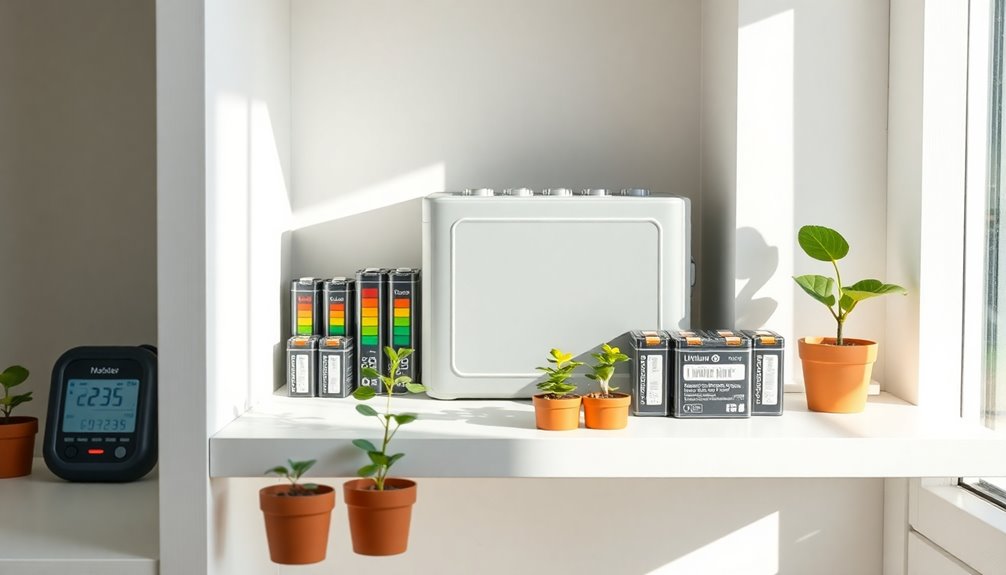
When storing lithium batteries, aim to keep them charged between 40% to 60% for ideal performance.
A full charge can actually increase wear and lead to capacity loss over time.
Don't forget to check your batteries every three months to maintain this charge level and avoid irreversible damage.
Ideal Storage Charge Level
A charge level between 40% and 60% is perfect for storing lithium batteries long-term.
This range helps prevent capacity loss and protects battery health. Storing at full charge can stress components, while deep discharge can cause irreversible damage.
Here's what you should keep in mind:
- Regularly check charge levels every three months.
- Avoid both full charge and deep discharge for ideal charge levels.
- Maintain a record of charging dates to track performance.
Risks of Full Charge
Storing lithium batteries at full charge might seem convenient, but it poses significant risks that can jeopardize their lifespan and safety.
Keeping your batteries fully charged during long-term storage can stress their components, leading to accelerated capacity loss. Instead, aim for a charge level between 40-60% to maintain ideal performance.
A fully charged battery also increases the risk of thermal runaway, potentially resulting in spontaneous ignition or even explosions under certain conditions.
To mitigate these risks, it's important to periodically check and adjust your battery's charge levels, ideally every three months.
Following manufacturer guidelines against storing batteries at full charge is vital for extending their lifespan and ensuring safer storage conditions.
Periodic Charge Maintenance
Maintaining the right charge level for lithium batteries is essential for their longevity and performance. To prevent capacity loss and irreversible damage, aim for an ideal charge level of 40-60% during storage.
Here are some key points to remember:
- Avoid charging to 100% before storage, as this accelerates degradation.
- Perform regular maintenance checks every three months to verify charge levels are adequate.
- Never let batteries drop below 20% capacity to prevent deep discharge.
These practices not only help maintain battery health but also extend their lifespan.
Documenting your charging dates can further assist in keeping track of your periodic charge maintenance, confirming your batteries remain in top condition throughout their storage period.
Organizing Your Batteries

Effective organization of your lithium batteries can greatly enhance safety and usability. Start by organizing batteries by type and age to prevent chemical interactions and guarantee easy tracking of their lifecycle.
Create a labeled storage area, categorizing different battery types and sizes, which streamlines access and improves inventory management. Maintain a written record of battery specifications and charging history to monitor performance and facilitate future use.
Regularly review and update your inventory to confirm batteries are stored efficiently and identify any that require maintenance. Use appropriate storage containers with non-conductive dividers to prevent physical damage and promote proper organization among multiple batteries.
This way, you'll keep your batteries safe and effective for longer use.
Safe Handling Practices
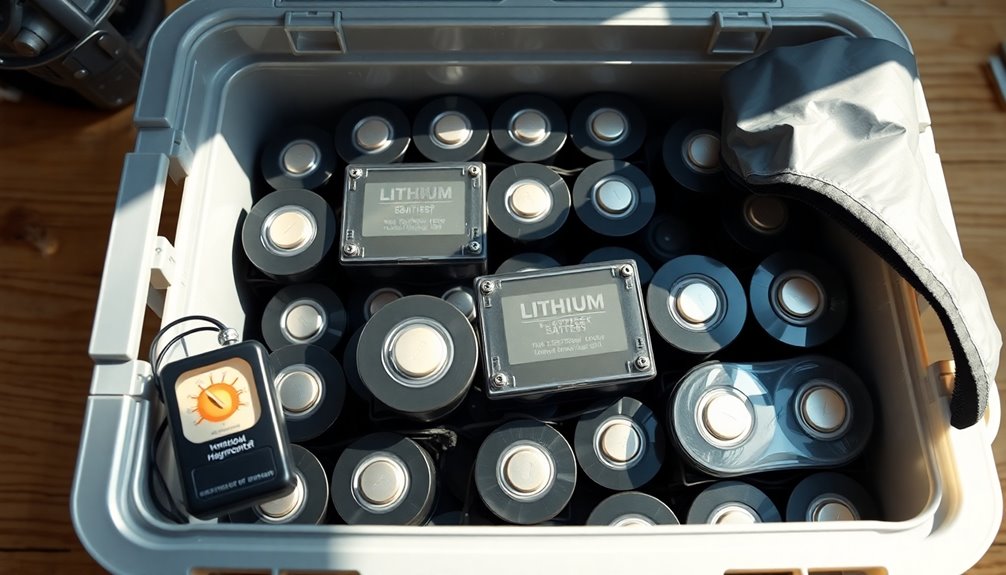
While handling lithium batteries, it's vital to exercise caution to prevent accidents and guarantee safety. Here are some safe handling practices to follow:
- Always avoid physical damage like punctures or drops.
- Use non-conductive dividers when storing lithium-ion batteries together.
- Regularly inspect stored batteries for swelling, leakage, or corrosion.
Maintain a consistent storage environment by keeping batteries in a cool, dry, and well-ventilated area to minimize risks.
Following manufacturer safety guidelines further assures proper handling and peak performance.
By being vigilant and proactive, you can maximize the lifespan of your batteries while minimizing hazards.
Environmental Considerations
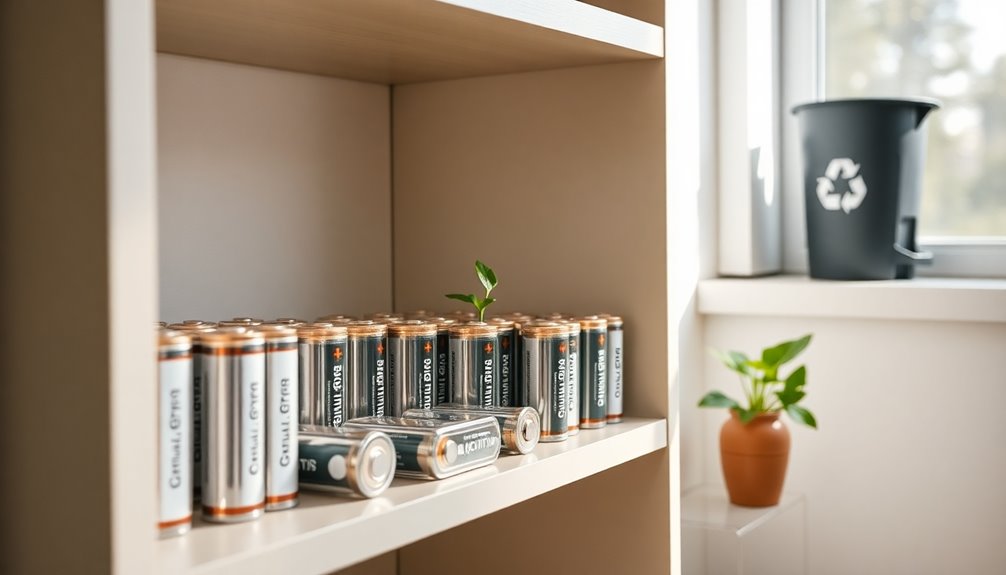
When you store lithium batteries, considering the environment is essential for ensuring their longevity and safety. Proper storage helps reduce environmental impact by extending battery life, which lowers material consumption and greenhouse gas emissions. Here are some best practices for battery care:
| Best Practices | Benefits |
|---|---|
| Store in a dry environment | Minimizes moisture exposure |
| Avoid mechanical damage | Maintains battery integrity |
| Implement regular checks | Enhances battery longevity |
| Use protective cases | Prevents punctures and dents |
Monitoring Battery Condition
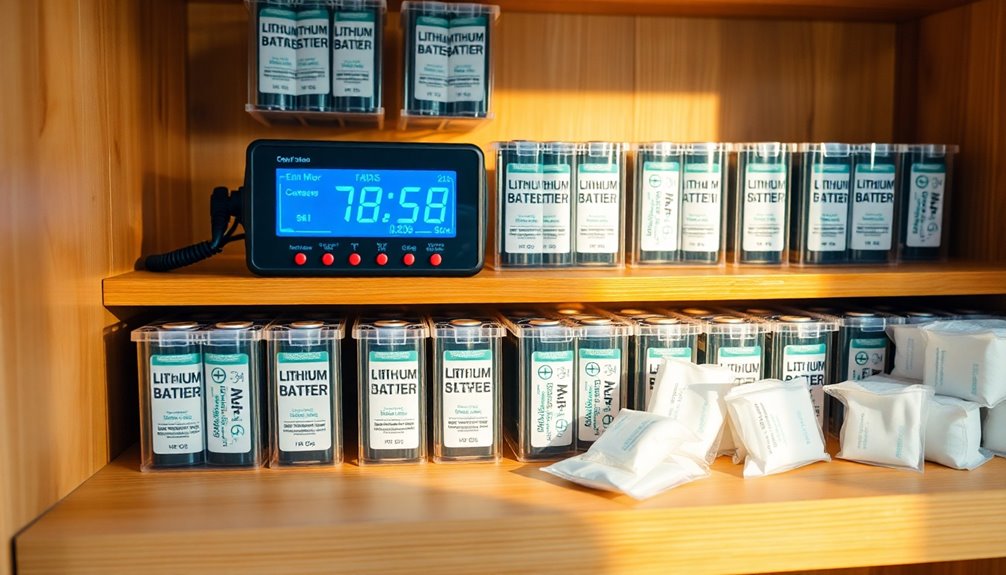
Regular monitoring of lithium batteries is essential for maintaining their condition and safety. By actively checking their status, you can prevent potential hazards and extend battery life.
Here are some key practices to follow:
- Regularly inspect for physical damage like swelling or leakage.
- Maintain a written record of charging dates and battery health assessments.
- Utilize a battery management system (BMS) to monitor charge levels and health.
Ensure you keep charge levels between 40-60% for long-term storage, as this prevents capacity loss.
Additionally, watch for fluctuations in temperature conditions and humidity, since they greatly impact battery lifespan.
Long-Term Storage Tips
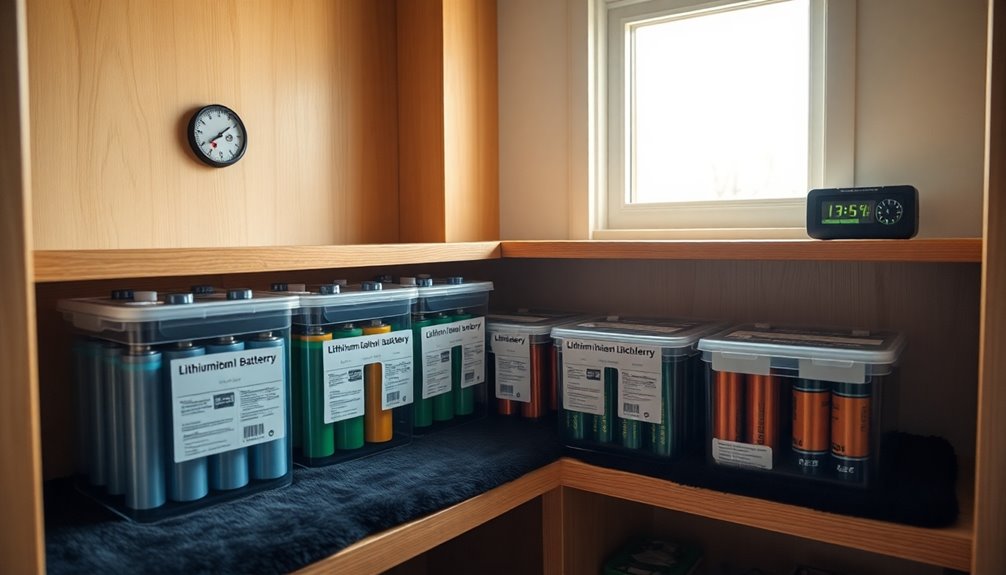
To guarantee your lithium batteries remain in good condition during long-term storage, it's important to charge them to a level between 40-60% capacity. This practice helps prevent capacity loss and irreversible damage.
When you store your battery, aim for temperatures between 20°C and 25°C (68°F to 77°F), as extreme temperatures can degrade performance. A cool, dry, and well-ventilated area is ideal, minimizing humidity and temperature fluctuations.
Regularly check the charge levels every three months; if you notice a drop, recharge as necessary to avoid deep discharge, which can lead to permanent damage.
Additionally, maintaining a written record of charging dates and conditions will help you track the longevity of your batteries and promote timely maintenance.
Frequently Asked Questions
How to Store Lithium Batteries for Long Term?
When you store lithium batteries for the long term, keep them charged to about 40-60%.
Find a cool, dry space with temperatures between 20°C and 25°C.
Regularly check the humidity and use dehumidifiers if needed.
Inspect your batteries every three months to guarantee they're in good shape and recharge them as necessary.
Organize batteries by type and age, using non-conductive dividers to avoid any chemical interactions.
Where Is the Safest Place to Store Lithium Batteries?
Did you know that storing lithium batteries at temperatures above 25°C can reduce their lifespan by up to 20%?
To find the safest place for your batteries, choose a cool, dry area with temperatures between 20°C and 25°C. Avoid attics or garages where temperatures fluctuate.
Keep them out of direct sunlight and away from heat sources. Consider using moisture-absorbing packets to prevent humidity, ensuring your batteries stay safe and effective for longer.
Is It Safe to Store Lithium Batteries in the Garage?
Yes, it's safe to store lithium batteries in the garage, as long as you maintain a temperature between 20°C to 25°C (68°F to 77°F).
Make sure your garage is well-ventilated to avoid overheating and keep humidity levels low to prevent condensation.
Don't place batteries near heat sources or direct sunlight, and consider using insulated containers during winter to protect against freezing.
Regularly check the conditions for ideal battery health.
How Can I Make My Lithium Battery Last Longer?
Imagine your lithium battery as a delicate flower; it thrives with the right care.
To make your battery last longer, keep it charged between 40-60%. Store it in a cool, dry spot, ideally between 20°C to 25°C.
Regularly check the charge every three months, ensuring it doesn't drop too low. Avoid extreme temperatures and direct sunlight, just like a flower needs shade from harsh conditions to bloom beautifully.
Conclusion
By taking a few simple steps, you can guarantee your lithium batteries enjoy a long and happy life. Storing them in the right conditions, managing their charge levels, and keeping an eye on their overall health will make all the difference. Think of it as giving your batteries a cozy home where they can thrive. So, treat your batteries well, and they'll reward you with reliable performance whenever you need it!

